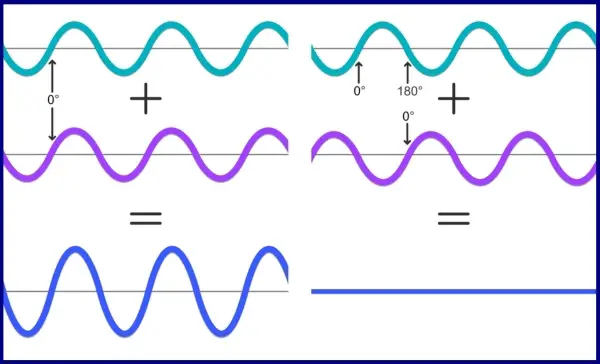What is Subwoofer Phase?
A subwoofer is an essential component in a sound system that reproduces low-pitched audio frequencies known as bass. With it, listeners can experience the full depth and dimension of music, movies, and other forms of multimedia.
One aspect of subwoofers that often goes overlooked is the subwoofer phase. It may seem like a technical detail reserved for sound engineers or audiophiles, but in reality, understanding it can have a massive impact on your sound output.
What is subwoofer phase? To put it simply, it refers to the timing of the sound produced by the subwoofer in relation to the speakers’ output.
When the subwoofer and the speakers are in phase, they work together to deliver the best possible sound. When they’re out of phase the subwoofer can negate or cancel out the sound from the speakers, leading to less than optimal audio quality.
Basic Concepts in Sound and Subwoofer
To truly grasp the concept of what subwoofer phase is, it’s essential to first understand some basic principles of sound and the role of a subwoofer in a stereo system.
Explanation of Sound Waves and Their Properties
Sound is energy that travels in waves, much like the ripples expanding across the surface of a still pond when a stone is thrown into it. Sound waves are produced by vibrating objects. These vibrations are transmitted through air or other media, causing the surrounding air particles to move and create waves.
The main properties of sound waves include frequency, amplitude, and phase. Frequency refers to the rate at which a wave oscillates in one second and is measured in hertz (Hz). It determines the pitch of the sound. Amplitude is the size of the vibration and determines the loudness or volume of the sound.
Then, there’s phase – a concept that refers to the position of a point in time on a waveform cycle. It’s measured in degrees, with 360 degrees being one full cycle.

Introduction to the Subwoofer
A subwoofer is a type of loudspeaker that’s specifically designed to reproduce low-pitched audio frequencies, typically those below 200 Hz. This range includes the lowest frequency humans can hear (around 20 Hz) and the lower threshold of mid-range frequencies (200-250 Hz).
Subwoofers are vital in a music audio system because standard speakers are not capable of effectively producing low-frequency sounds like a subwoofer can. The subwoofer’s role is to fill in this gap and produce the deep bass sounds that provide a fuller, richer sound experience.
Together, the subwoofer and the speakers create a sound stage that aims to encompass the listener.
Understanding Phase in Sound
Phase, in the context of sound and acoustics, is a critical aspect that can significantly influence how we perceive and interpret sound. It deals with the timing and alignment of sound waves, playing a significant role in the cohesion of the sounds we hear.
Definition of Phase in the Context of Sound
Phase refers to a certain point in the cycle of a wave. It’s a way of describing the position or state of a wave in its oscillation cycle at any given point in time. It’s often measured in degrees or radians, where 360 degrees or 2π radians represents one full wave cycle.
When considering multiple sound waves, the term phase also refers to the relationship between these waves. If two waves reach their peak at the same time, they are considered to be ‘in phase.’ And, if one wave reaches its peak when the other is at its lowest point, they are ‘out of phase.’
Impact of Phase on the Perception of Sound
The concept of phase is important when dealing with multiple sound sources, such as in an audio system with speakers and a subwoofer. When all these components are in phase, the waves they produce work together, leading to louder and clearer sound.
However, when these components are out of phase, their sound waves can cancel each other out, leading to a noticeable reduction in sound quality. This might manifest as a lack of bass, a perceived hole in the frequency response, or the sound seeming to come from the wrong direction.

What is Subwoofer Phase?
After laying the groundwork with the basic principles of sound and phase, we can now delve into the concept of subwoofer phase and understand exactly what it is.
Detailed Explanation of Subwoofer Phase
Subwoofer phase refers to the timing of the sound produced by the sub compared to the sound produced by the main speakers in an audio system. It’s about how the sound waves produced by the subwoofer align with the sound waves from the speakers.
This is important because low-frequency sound waves (those produced by the subwoofer) are much longer than high-frequency sound waves (those produced by the speakers). If they’re not properly aligned – that is, if they are not ‘in phase’ – they can interfere with each other in ways that can degrade the overall sound quality.
In practical terms, the phase control on a subwoofer typically has two settings: 0 degrees (normal phase) and 180 degrees (reverse phase). The 0 degrees setting means the subwoofer is ‘in phase’ with the main speakers – it moves in and out in sync with them. The 180 degrees setting puts the subwoofer ‘out of phase’ with the speakers – it moves in the opposite direction.
Explanation of How Phase Alignment or Misalignment Occurs
Phase alignment or misalignment can occur due to various factors, including the position of the speakers and sub, the listening position, and the acoustics of the room. These factors can affect the path length of the sound waves from the speakers and the subwoofer to the listener, causing them to arrive at slightly different times and leading to phase issues.
For example, if the subwoofer is closer to the listener than the main speakers, the sound from the subwoofer may arrive slightly earlier, creating a phase mismatch. This can cause some of the sound waves to cancel each other out, leading to diminished audio quality.
It’s important to note that perfect phase alignment is not always achievable or necessary, but getting the phase as close as possible can make a significant difference in audio reproduction quality.

The Importance of Correct Subwoofer Phase Setting
Setting the correct phase on a subwoofer plays a significant role in the overall performance and sound reproduction of your audio set up. It has a direct impact on the system’s capacity to deliver precise, clean, and rich sound.
Effects of Incorrect Phase Setting
When a subwoofer and the speakers are out of phase, they work against each other, leading to a reduction in bass response and overall sound quality. This is because the sound waves they produce are at opposite points in their cycles, leading to destructive interference.
The effects of incorrect phase setting can be subtle or dramatic depending on the severity of the phase mismatch. At its worst, a severe phase mismatch can lead to almost total cancellation of certain frequencies, leaving a noticeable hole in the sound output.
Phase issues can also affect the stereo imaging of the audio system. This can disrupt the listeners’ ability to accurately place sound sources within the soundstage, creating an unbalanced or unnatural listening experience.
How Correct Phase Setting Enhances Sound Reproduction
On the flip side, when the subwoofer and speakers are correctly phased, the sound waves they produce work in harmony, leading to constructive interference. This results in a stronger and cleaner bass response, as well as improved sound quality across all frequencies.
Correct phase setting allows for a more seamless blend between the sub and the speakers, which is especially crucial for home theater systems where achieving a realistic, immersive sound field is key.
With the correct phase setting, you’ll enjoy a more cohesive, detailed, and immersive listening experience, whether you’re watching a movie, playing a video game, or simply listening to your favorite music.

How to Adjust Subwoofer Phase
Understanding the importance of phase alignment is one thing, but knowing how to adjust your subwoofer phase to achieve optimal sound output is another. Here, we provide a step-by-step guide to help you adjust your subwoofer phase effectively.
Step-by-Step Guide on Adjusting Subwoofer Phase
- Locate the Phase Control: Check the back of your subwoofer for a knob or switch labeled “Phase.” Typically, it will have two settings: 0 and 180 degrees.
- Start with the Default Setting: Set the phase control to 0 degrees (in phase). This is the default setting where the subwoofer is working in sync with the speakers.
- Listen and Evaluate: Play some music or a movie scene with a good amount of bass. Listen carefully to the sound quality, especially the bass response.
- Adjust the Phase: Switch the phase to 180 degrees (out of phase). Listen again to the same music or movie scene.
- Compare and Decide: If the bass response is stronger and the overall sound quality is better with the phase set to 180 degrees, keep it there. If not, switch it back to 0 degrees.
Expert Tips for Setting the Phase Right
- Use Test Tones: You can use test tones designed to help adjust subwoofer phase. These are available on various calibration discs and online platforms.
- Room Positioning: Remember that changing the subwoofer’s position in the room can affect phase alignment. If you move the subwoofer, you may need to recheck the phase setting.
- Multiple Subwoofers: If you’re using more than one subwoofer, you’ll need to adjust the phase of each one to ensure they all work together harmoniously.
- Trust Your Ears: At the end of the day, the best phase setting is the one that sounds best to you in your listening room. Don’t be afraid to experiment until you find the optimal setting.
Remember, correct phase setting is a crucial component of achieving the best sound quality from your audio system. Take the time to adjust and fine-tune your subwoofer phase for the most enjoyable listening experience.
What is Subwoofer Phase?
Understanding the concept of subwoofer phase is vital for anyone wanting to perfect their sound reproduction. Whether you’re a casual listener or an audiophile, knowing how to adjust your it can significantly enhance your listening experience.
Remember, phase refers to the timing of the sound waves produced by your subwoofer in relation to those produced by your main speakers. If these are out of sync, the overall sound quality of your system can be compromised. However, when properly aligned, they work together to create a richer, more immersive sound.
FAQs
What phase is best for subwoofer?
The best phase for a subwoofer is the one that results in the most coherent and powerful bass response when combined with your main speakers. This could be either 0 degrees or 180 degrees, depending on several factors such as the placement of the speakers and subwoofer, room acoustics, and your listening position.
Should a subwoofer be in phase or out?
Generally, your subwoofer should be in phase with your main speakers to ensure a seamless and effective blend of frequencies. However, based on factors like subwoofer placement and room acoustics, sometimes adjusting the phase to 180 degrees might result in better sound.
Should subwoofer phase be 0 or 90?
Subwoofers typically have phase switches that allow adjustments to be made at either 0 or 180 degrees, not 90. The ideal setting, either 0 or 180, depends on your specific setup, the placement of your subwoofer, your main speakers, and how they interact with your room’s acoustics.
What is the difference between phase 0 and 180 on a subwoofer?
The phase switch on a subwoofer adjusts the timing of the sound wave produced by the subwoofer relative to the sound waves produced by the main speakers. A setting of 0 degrees means that the subwoofer is in phase with the speakers – it moves in and out in sync with them. A setting of 180 degrees puts the subwoofer out of phase with the speakers – it moves in the opposite direction.
Should two subwoofers be set to phase 0 or 180?
If you are using two subwoofers, both should generally be set to the same phase that offers the best sound when combined with your main speakers. This could be either 0 degrees or 180 degrees. However, if the subwoofers are not equidistant to the listener, you might need to adjust the phase individually for each subwoofer to achieve the best result.
How do I know if my subwoofer is out of phase?
If your subwoofer is out of phase, you might notice a lack of bass or a perceived hole in the frequency response. The overall sound might seem less coherent, and the stereo imaging could be off, making the sound seem to come from the wrong direction. To test this, you can toggle between 0 and 180 on the subwoofer phase control while playing music and listen for which setting gives a fuller, more balanced sound.
Can incorrect subwoofer phase damage my audio system?
No, having your subwoofer phase incorrectly set won’t damage your audio system, but it can degrade sound quality. If the phase is not properly aligned, the subwoofer and main speakers may cancel each other out at some frequencies, leading to a weaker and less balanced sound.
Do all subwoofers have a phase switch?
Not all subwoofers come with a phase switch. Some subwoofers have a continuously variable phase control that allows finer adjustments than just 0 and 180 degrees. Others might not have any phase adjustment feature, especially older models.
Does the phase setting affect the volume of the subwoofer?
The phase setting itself doesn’t directly alter the volume of the subwoofer. However, when it’s correctly set, the sound from the subwoofer and the main speakers should blend more seamlessly, which could result in a perceived increase in overall sound level, especially in the bass frequencies.
Does room size affect subwoofer phase?
While the room size itself doesn’t directly affect the subwoofer phase, it can influence the acoustic properties of the space and the path length of sound waves from the speakers and subwoofer to the listener. These factors can cause the sound waves to arrive at slightly different times, potentially leading to phase issues.

I am a passionate and skilled car audio enthusiast with 15 years of experience in the industry. My journey started when I replaced my first set of factory car speakers, sparking a deep love for high-quality sound. Since then, I have worked as a representative for renowned brands like Kenwood and Alpine.
With a background in both retail and distribution, I have developed a comprehensive understanding of the car audio market. Currently a certified (MECP) installer in the Mobile Electronics industry, my expertise lies in delivering top-notch audio installations. My knowledge, coupled with my genuine passion, makes me the go-to professional for all car audio needs.


